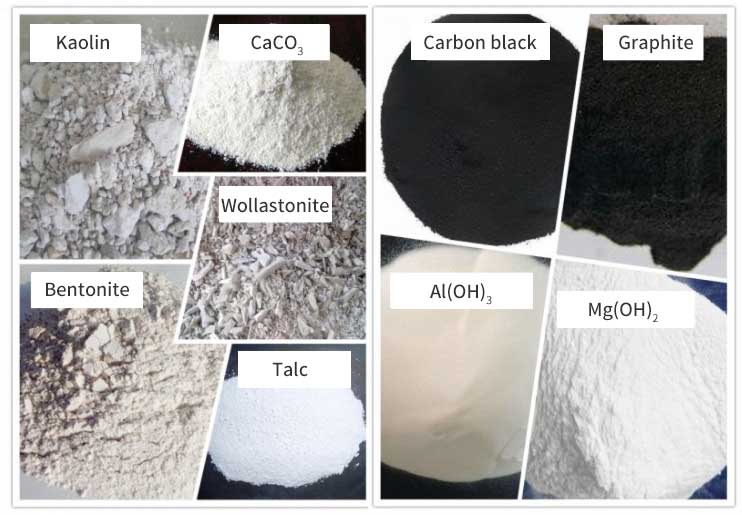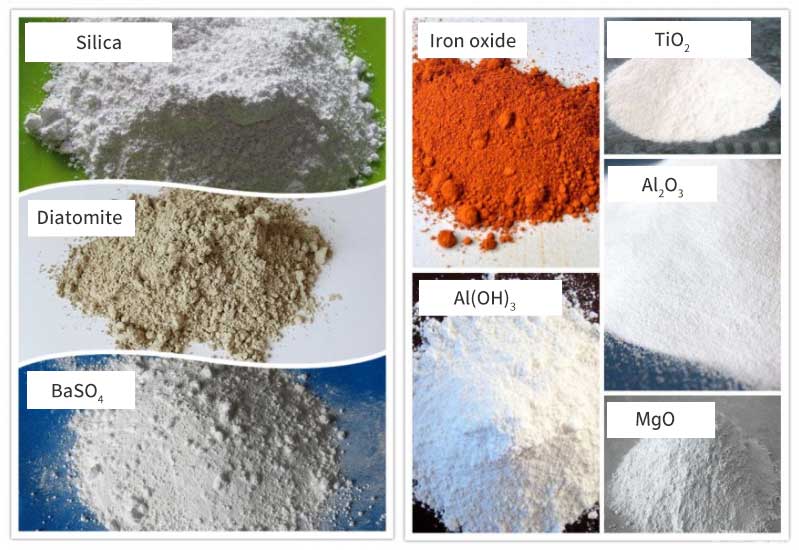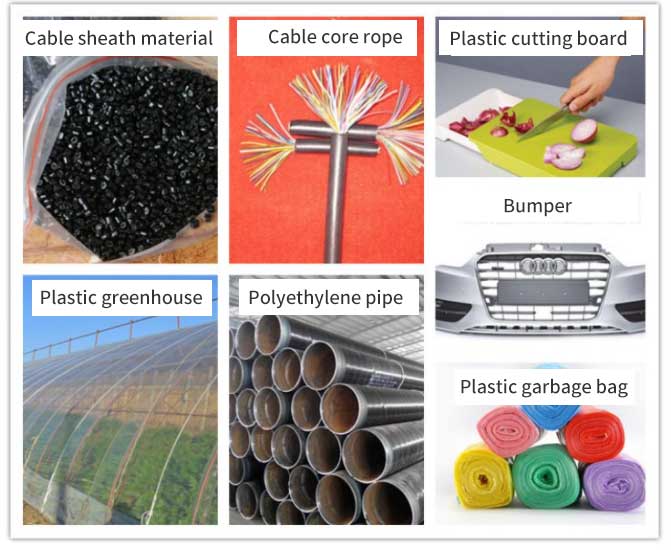Application of non-metallic mineral fillers in plastics industry
Non-metallic mineral fillers generally refer to non-metallic mineral materials that exist in nature and are artificially mined, processed and used to have improved strength and various properties, or to reduce costs, and are added to plastics.
Non-metallic mineral fillers are divided into: oxide, hydroxide, carbonate, (sulfite), silicate, carbon, etc. Oxides mainly include: silicon dioxide, diatomaceous earth, aluminum oxide, titanium dioxide, iron oxide, zinc oxide, magnesium oxide, pumice powder, etc. Hydroxides mainly include: aluminum hydroxide, magnesium hydroxide, basic magnesium carbonate and so on. Carbonates mainly include calcium carbonate, magnesium carbonate, dolomite, basic sodium aluminum carbonate and so on. (Sulfite) mainly includes barium sulfate, ammonium sulfate, calcium sulfate, calcium sulfite and so on. Silicates mainly include talc, clay, mica, asbestos, calcium silicate, montmorillonite, bentonite, glass beads, glass fiber, etc. Carbon mainly includes carbon black, graphite, carbon hollow spheres, carbon fiber, etc. In addition, non-metallic mineral fillers include zinc borate, calcium borate, sodium borate, barium metaborate, and potassium titanate.


The main modification technologies of non-metallic mineral fillers are: surface chemical modification, surface physical coating, plasma surface treatment, phase solvent treatment, mechanical chemical modification, surface graft modification, precipitation reaction modification, in-situ Polymerization technology.
Physical properties and their effects
Specific surface area: The larger the specific surface area, the better the affinity between the filler and the resin, but the more difficult it is to activate the filler surface and the higher the cost.
Hardness: High hardness can improve the wear resistance of the product, but it will wear the processing equipment.
Color: Most plastic production requires Baidu as high as possible.
Optics: Some products can use their light absorption to increase the temperature, such as: agricultural plastic greenhouses.
Electricity: Condensation or crushing on the surface of the particles causes the valence bonds to be broken and charged, causing uneven particle distribution, which should be avoided in actual production.
Chemical properties and effects
Chemical composition: Affects the corrosion resistance, resin structure and qualitative properties of the product. Different types of fillers have different effects on the product, and different fillers are selected according to the required product characteristics.
Thermochemical effect: High molecular polymers are easy to burn, but most inorganic mineral fillers are added to the polymer matrix to reduce the quality of combustibles and delay basic combustion due to their own inconsistency.
Performance requirements for fillers: high chemical stability, good heat resistance, good dispersion and mixing in plastic resin, small absorption of plastic resin, high purity, insoluble in solvents, good acid and alkali resistance, and no moisture absorption.
The role of fillers in plastics
- Calcium carbonate
Calcium carbonate is currently the most widely used powder filler in the plastics industry. Because of its low price, white color, and good processing performance, heavy calcium carbonate can meet the performance requirements of filled plastics, and its dosage is greatly increased.
- Talcum powder
Talcum powder in plastics can improve the rigidity and heat resistance of plastics, and can increase the light transmittance of film scattering rate in plastics, and has a blocking effect on infrared rays with a wavelength of 7-25μm. It has been used in functional films to improve the nighttime of the greenhouse. Heat preservation and promote the growth of crops.
- Kaolin
Kaolin in PVC cable material can significantly improve the electrical insulation of cable sheath; in plastic film, kaolin has better infrared blocking effect than talc, and is used for agricultural film modification; it is also used for polypropylene to make core Agent to improve its mechanical strength.
- Wollastonite
Wollastonite can be used as a plastic reinforcement, can improve the abrasion resistance and dimensional stability of plastic products, and can improve the flame retardant effect of organic flame retardants.
- Mica
The unique flake structure of mica makes it a typical reinforcing filler in plastics, which is mainly used to improve the rigidity, heat resistance and dimensional stability of plastic products. When mica is used in plastic film, its scattered light transmittance can be greatly improved, which is better than other inorganic fillers.
- Aluminum Hydroxide and Magnesium Hydroxide
Aluminum hydroxide and magnesium hydroxide have the three functions of filling, flame retardant and smoke suppression in plastics; they are also the main additives for PVC conveyor belts used in coal mines, and are often filled with epoxy resin and unsaturated polyester products. Adding agent, the amount can reach more than 40%.
The influence of various fillers on plastic properties
| Performance | Calcium silicate | Mica | Talc | Graphite | Quartz |
| Tensile strength | + | 0 | |||
| Compressive strength | + | + | |||
| Elastic modulus | ++ | ++ | + | + | |
| Impact strength | – | – | – | – | |
| Reduce thermal expansion | + | + | + | + | |
| Reduce shrinkage | + | + | + | + | + |
| Thermal conductivity | + | + | + | + | |
| Thermal stability | + | + | + | ||
| Conductivity | + | ||||
| Electrical insulation | + | ++ | + | ||
| Heat resistance | + | + | + | + | |
| Chemical resistance | + | + | 0 | + | |
| Wear resistance | + | + | + | ||
| Extrusion rate | + | ||||
| Wear to the machine | 0 | 0 | – | ||
| Inexpensiveness | + | + | + | + | ++ |
(++ means high efficiency, + medium efficiency, 0 invalid,-reverse effect)
| Performance | Wollastonite | Clay | Calcium carbonate | Carbon black |
| Tensile strength | + | |||
| Compressive strength | + | |||
| Elastic modulus | + | + | + | |
| Impact strength | – | – | – | – |
| Reduce thermal expansion | + | + | + | + |
| Reduce shrinkage | + | + | + | + |
| Thermal conductivity | + | + | ||
| Thermal stability | + | |||
| Conductivity | + | |||
| Electrical insulation | + | ++ | ||
| Heat resistance | + | + | + | |
| Chemical resistance | + | |||
| Abrasion resistance | + | |||
| Extrusion rate | + | + | ||
| Wear on the machine | 0 | 0 | ||
| Inexpensiveness | + | + | + |
(++ means high efficiency, + medium efficiency, 0 invalid,-reverse effect)
Plastics with non-metallic minerals added

The role of fillers in plastics
Cost reduction: cheap fillers are added to plastics as fillers to reduce costs. Representative examples include the addition of large amounts of calcium carbonate to polyvinyl chloride and polypropylene.
Improve mechanical properties: Compared with polymer resins, non-metallic minerals have higher hardness and modulus, and its active surface can be combined with polymer chains, so the appropriate addition of non-metallic minerals can effectively improve plastic hardness, modulus, strength and other machinery performance.
Enhanced flame-retardant performance: non-metallic minerals have the advantages of good thermal stability, low toxicity or non-toxicity, no corrosive gas, no play during storage, difficult to precipitate, long-lasting flame retardant effect, etc., and they have abundant raw materials and low prices. It is still a simple and effective method to solve the problems of flame retardancy, low smoke and low toxicity of a large number of flammable engineering plastics.
Enhanced stability: Plastics are used in a variety of environments. Non-metallic mineral fillers can enhance the stability of plastics, such as thermal stability, electrical stability, solvent resistance, and light and thermal aging resistance.
Function: After adding most fillers, plastic products have special functions that they did not have before. This is because the chemical composition of the filler plays an important role. For example, adding graphite can increase the conductivity and wear resistance of the plastic.
The use of mineral fillers in plastic products
| Plastic products | Type of filler used | Adding amount (phr) | Effect |
| Polypropylene tape | Calcium carbonate | 10~20 | Increase, whiten, improve printability |
| Polypropylene strapping | Calcium carbonate | 50~150 | Increase and increase the friction coefficient |
| Polyethylene film | Calcium carbonate | 40~50 | Incremental and environmentally friendly |
| Polyethylene pipe | Calcium carbonate | 20~40 | Increment |
| Polyethylene winding pipe, corrugated pipe | Talc | 20~40 | Increase rigidity |
| Polypropylene injection molded products | Calcium carbonate,talcum powder | 40~50 | Replace ABS, reduce costs |
| Polyethylene Greenhouse Film | Talc, Kaolin | 5~10 | Improve heat preservation |
| Polyethylene garbage bag | Calcium carbonate | 40~50 | Improve incineration |
| Polypropylene snack tray | Calcium carbonate | 200 | Reduce costs and improve stability |
| Bumper | Talc | 20~30 | Maintain rigidity and improve impact resistance |
| Automobile and home appliance parts | Talc | 30~50 | Improve heat resistance |
| PVC doors and windows profiled materials | Calcium carbonate | 10 | Improve toughness and forming processability |
| PVC pipe | Calcium carbonate | 20~60 | Reduce costs |
| PVC foam material | Calcium carbonate | 30~80 | Reduce costs and improve uniformity |
| PVC decorative board | Calcium carbonate | 200 | Reduce costs |
| Cable sheath material | Calcium carbonate | 10~15 | Reduce costs |
| PVC artificial leather | Calcium carbonate | 10~60 | Increment, reduce costs |
| Power cable core rope | Calcium carbonate | 180~200 | Reduce costs |
| High insulation power cable sheath material | Calcined kaolin | 10~15 | Improve electrical insulation strength |
| High gloss polypropylene | Precipitated barium sulfate | 40~50 | Maintain the gloss of the plastic surface |
| Halogen-free low-smoke cable sheath material | Aluminum hydroxide, magnesium hydroxide | 150 | Flame retardant, smoke suppression |
| Motor fan blades for automobiles, etc. | Mica | 40~50 | Improve heat resistance |
| Cases and parts of air conditioners, televisions, etc. | Calcium carbonate, talcum powder | 40~60 | Reduce costs and improve dimensional stability |
The main motivation for using mineral fillers is to reduce the cost of raw materials for plastic products, so price is the primary influencing factor. Coarse particle size fillers tend to be cheaper than fine particle size fillers. Not all plastic products are suitable for the use of mineral fillers. Some are not suitable for use, such as transparent products; some are due to the problems caused by the use of mineral fillers, such as weight gain and poor coloring.
The smaller the particle size of the non-metallic mineral filler, the better the physical and mechanical properties of the filled plastic when used properly. However, within the range allowed by the current technical level and equipment conditions, the particle size is too small, but it is not easy to use, not only the price is high It also affects the fluidity of the molding process and the mechanical properties of the filling material.
More and more attention has been paid to the functionality of non-metallic mineral fillers. Therefore, when developing new varieties of mineral fillers, we must first consider what new functions it can bring to plastic materials.
Article source: China Powder Network
